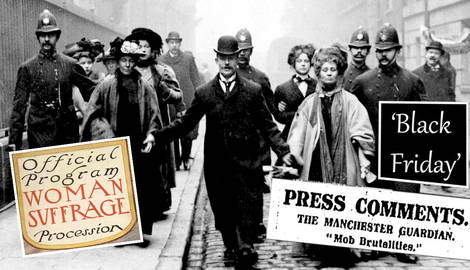
The Suffragettes fought tirelessly for women’s right to vote, embarking on a series of campaigns, actions and protests aimed at drawing maximum attention to their plight. Not content to sit on the sidelines of society, they embarked instead on a series of headline grabbing protests, ranging from the peaceful to the antagonistic, all in the name of breaking free from the tyranny of institutionalized sexism. Below we take a look at just a handful of the many protests organized by the suffragettes throughout the United Kingdom and the United States, which have gone down in the history books as legendary moments of great societal significance.
Mud March (suffragists): 9 February 1907, London

The United Procession of Women, or what became known as the Mud March, was a relatively peaceful protest organized by the National Union of Women’s Suffrage Societies (NUWSS). Around 3,000 women gathered in London’s Hyde Park Corner and proceeded to march all the way to the strand, making this the largest, longest, and most public intervention the suffragettes had ever staged. The event was dubbed the ‘Mud March’ because participants were completely drenched by torrential rain, and splattered by the subsequent muddy ground they had to trudge through.
The purpose of the march was to raise awareness to the opening of parliament where a women’s suffrage bill was being proposed. While the event failed to lead to a vote, it set a precedent for future large-scale suffrage events in the subsequent years and decades that followed.
The Black Friday Protests: 18 November 1910, London

Another prominent event in British history was the Black Friday Protests of 1910. More than 300 suffragettes who were members of the Women’s Social and Political Union (WSPU) marched FROM Caxton Hall to Parliament Square. The march was staged in anger at the government’s failure to accept the 1910 Conciliation Bill, which had been designed by government to appease the suffragettes, offering a limited franchise for women based on property qualification.

This event stood out in history as it was marked by violent clashes between female protestors and the police, leading to a horrifying ordeal involving violence and sexual assault. A group of MPs gathered evidence from both sides of the conflict and called for a public enquiry, but it was rejected by Home Secretary Winston Churchill. Due to the government’s poor handling of the situation, suffragette protests became increasingly flagrant and defiant, as women expressed their growing frustrations about not being heard or taken seriously.
Women’s Suffrage Parade in Washington DC: 3 March 1913

Thousands of women took to the streets of Washington on the 3rd of March 1913, calling for the government to revise women’s non-existent voting rights. This huge public protest was organized by the National American Woman Suffrage Association and included around 5 thousand women accompanied by a series of mounted brigades, bands and parade floats. In order to maximize public interest, they deliberately organized their event just a day before President Woodrow Wilson’s inauguration.

Like many suffragette protests, many women were injured by acts of violence from those in opposition. However, the protest did much to invigorate the suffragette movement in the United States, and played a significant role in securing the Nineteenth Amendment seven years later in 1920.
The 1913 Suffrage Pilgrimage: 26 July 1913, London

The Suffrage Pilgrimage of 1913 was spearheaded by the National Union of Women’s Suffrage Societies (NWSS), who had gathered significant support by now with more than 100,000 members. Women marched from various points across England to Hyde Park, meeting at a rally staged on the 26th of July 1913. Some took over six weeks to complete the journey, breaking it into smaller parts by camping along the way, and some travelled by bicycle to make the passage easier.
The pilgrims wore a uniform of white, grey, black or navy-blue coats or dresses, with a white blouse and a hat adorned with red, white and green. They also wore satchels featuring shoulder straps made from red, white and green ribbons, and a red ribbon on the front. This meant passersby could easily recognize them, thus raising greater awareness of their cause. In contrast with many other suffragette protests the pilgrimage was peaceful in nature, despite its sum of around 50,000 participants.










